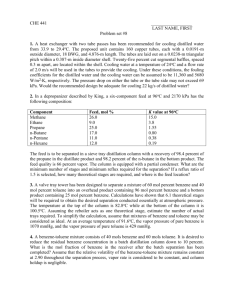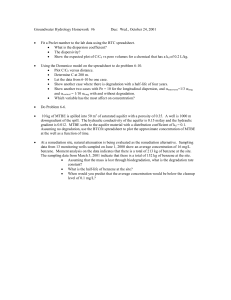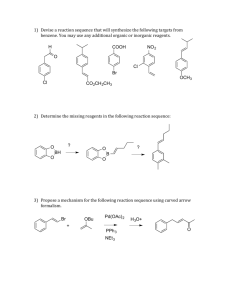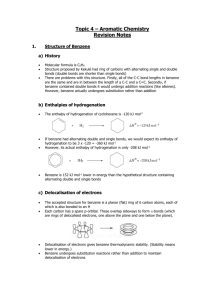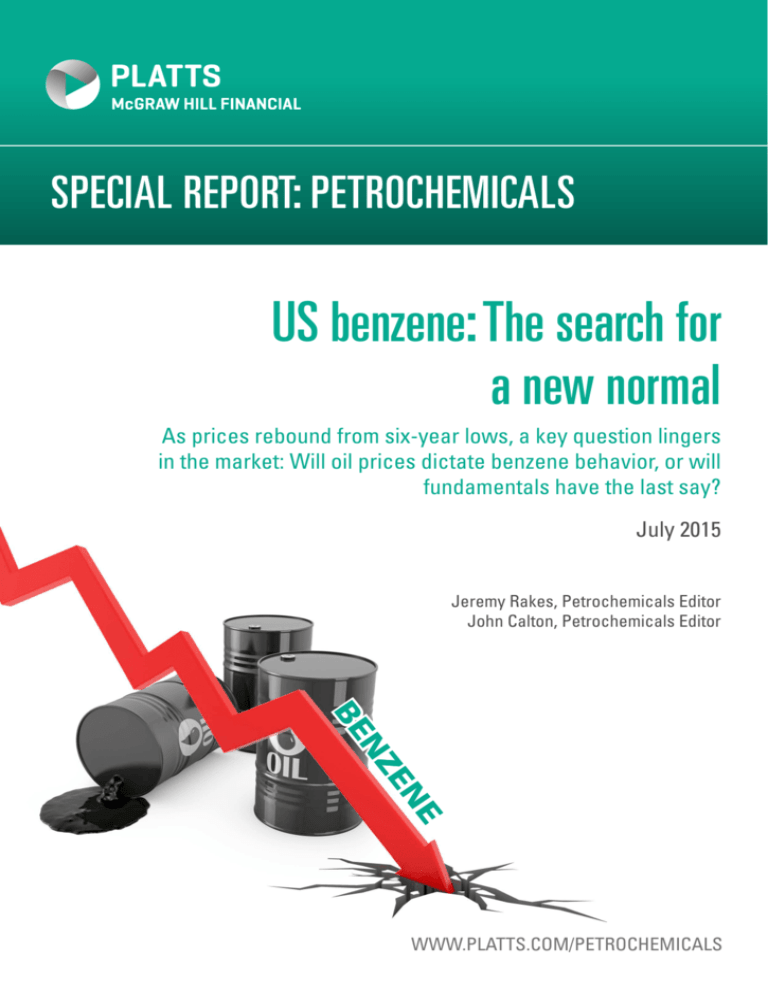
SPECIAL REPORT: PETROCHEMICALS
US benzene: The search for
a new normal
As prices rebound from six-year lows, a key question lingers
in the market: Will oil prices dictate benzene behavior, or will
fundamentals have the last say?
July 2015
Jeremy Rakes, Petrochemicals Editor
John Calton, Petrochemicals Editor
NE
ZE
N
BE
WWW.PLATTS.COM/PETROCHEMICALS
US benzene: The search for a new normal
WEAK BENZENE PRICES, OIL AND
MARKET FUNDAMENTALS
Conditions in the first half of 2015 resembled those seen in 2013, as
lower benzene prices have supported a stronger styrene market and
healthy margins. The US is a net exporter of styrene, so the attractive
arbitrage has been a welcome relief to sellers and traders.
Less than three years since first surpassing the $5/gallon ($1,495/mt)
mark and two years since participants began to ponder whether they
were witnessing a “new normal,” US benzene prices head into the
second half of 2015 averaging their lowest levels since at least 2009.
Five dollars as the new normal? Try half of that – or possibly lower
– if current fundamentals persist.
Market insiders need not look far in search of the reason for this
extraordinary shift in pricing behavior.
Driven by plummeting oil prices over the second half of 2014, US
benzene prices shed nearly 65% over the period, hitting a near-six
year low of 191 cents/gal in January.
And even as oil has shown moderate rebounds since and global
benzene prices tracked higher in Q2 – US spot pricing closed the
quarter at 296 cents/gal for a 35% increase – the gains have been
limited by improved product availability from Asia into the
net-short US.
For the two years ending in September 2014, US spot benzene prices
averaged $4.54/gal FOB US Gulf Coast, with the highest price at
$5.53/gal on January 15, 2014 and the lowest price at $3.92/gal on
October 22, 2012, based on Platts data. Much of the price volatility
was due to fundamentals – whether US benzene imports were
sufficient to satisfy demand – but also had to do with crude pricing
hovering in the $80-$110/barrel range.
During much of the same period, US spot styrene prices were
consistently in the 60s and 70s cents/lb FOB USG throughout 2012
and 2013 and for the first 10 months of 2014 before falling at the end
of the year. In 2013, spot styrene margins were healthy and the
market was active, but in 2012 and 2014, higher feedstock benzene
prices crushed margins and arbitrage opportunities and slowed
styrene activity.
Benzene decline (¢/gal)
500
During the fourth quarter of 2014, US benzene prices saw a steep
decline in pricing, resulting in a much larger drop than what is
generally seen and attributable to typical levels of volatility.
The falling benzene prices were attributed to the more than 50% drop
in crude and large volumes of benzene that arrived into the US from
Asia during that time. The imports arrived despite slow US demand in
key derivative styrene and phenol markets, adding additional
downward price pressure.
In 2015, US prices have treaded in territory not seen since 2009.
Market sentiment has been a rollercoaster since the decline, and a
common observation among participants is that just when the
benzene market starts to seem predictable, market conditions shift
and volatility returns.
The late- 2014 decline was the largest drop ever seen in US
benzene pricing over a four-month period, as prices tumbled as
much as 59%, or $2.73/gal, from the beginning of September, based
on Platts data. The drop in benzene prices coincided with falling
crude prices. Though the US benzene market tends to be driven by
supply balances because of its net-short position, crude pricing
plays a major role. As crude prices fell to near six-year lows, US
benzene prices followed suit.
The benzene-to-crude ratio is considered by many market players to
be an effective tool in determining the value of the aromatic. A higher
ratio can be interpreted as an indication that benzene prices are too
high and could move lower depending on fundamentals; a lower ratio
could mean the opposite. In a bearish market, US benzene is more
correlated with crude movement and in a bullish market, there’s more
of a disconnect, sources said.
The benzene-to-crude ratio has averaged 1.85 since May of 2009,
which is close to the typically accepted average of 1.80 in the market.
Market participants start to expect a price correction in the market
the higher or lower the ratio gets beyond this point.
During that period, the ratio peaked at 2.56 on July 13, 2012 and was
at its lowest point at 1.27 on November 30, 2011.
400
ASIA ARBITRAGE LEADS TO OVERSUPPLY
300
200
100
Sep-14
Source: Platts
Nov-14
Jan-15
Mar-15
May-15
At the end of 2014, US derivative demand was slow, while Asian
benzene inventories were in excess. An open arbitrage window to the
US from Asia is typical, and helps the US in balancing the supply
deficit to satisfy demand, but the end of 2014 was a different story.
Even during shorter periods when arbitrage economics for Asia to
send benzene to the US were unattractive, the US was still a popular
destination for product.
PLATTS SPECIAL REPORT: PETROCHEMICALS
|
2
US benzene: The search for a new normal
Arbitrage opportunities for Asia to send benzene to the US were
available off and on during the fourth quarter of 2014, but prior to
that, opportunities for Asia to send benzene into the US were most
attractive mid-June through August of 2014. In November and
December, the arbitrage window from Asia to the US was mostly
closed on paper, but exports to the US continued because of benzene
oversupply in that region.
The highest spread between FOB Korea and US pricing was
$104.31/mt on December 17, but a day later the spread fell to
$22.43/mt. The US typically needs around 120,000 metric tons
monthly to satisfy the production deficit, however slow demand
meant the US did not need as much supply as usual to satisfy
the shortage.
At least 300,000 tons of benzene arrived from Asia during November
and December, which was more than the US needed during that
period of slow demand, according to market participants.
Toluene – benzene spread (¢/gal)
100
50
0
-50
Sep-14
Nov-14
Jan-15
Mar-15
May-15
Source: Platts
Benzene vs RBOB prices (¢/gal)
600
500
The additional benzene resulted in excess inventories in the US
market. After December 19, the arbitrage window closed and has
remained closed during the first half of 2015, resulting in lower-thantypical benzene shipments from Asia since February. The average
shipment since has been in the 40,000-70,000 metric ton range, when
the usual import amount needed to satisfy the US production deficit is
at least 100,000 metric tons per month, sources said.
In February and the beginning of March, an atypical arbitrage flow
opportunity opened with the US exporting benzene to Asia. Market
sources described this event as a “reverse arbitrage.”
Despite an unattractive arbitrage window from Asia during the first
half of 2015, the US market has continuously struggled to absorb the
excess supply even though downstream styrene demand has been
considered strong by market participants since March.
In the longer term, Asia is expected to have more benzene to send
to the US because of new capacities coming online during
2015-2017. Around 1.4 million metric tons of new capacity is
scheduled to come online during this period, with 700,000 metric
tons of that new capacity expected to begin production in 2015.
While some of this benzene will be used to satisfy phenol demand
from added downstream phenol capacity in Asia, there will still be
excess supply.
The new benzene capacity is expected to add to the surplus of
benzene already seen in the Asian market, and the material will
have to have a destination. “The primary outlet [for the Asian
benzene] will be the US,” a source said. With this being said,
market participants looked at the possibility of $6/gal benzene
as a new normal during periods tight supply, despite this new
capacity coming online in Asia, because the shift to shale gas
has meant cracking lighter feedstocks, which ultimately will
lead to less benzene supply, leaving the US more dependent on
Asian imports.
3
|
400
300
200
Benzene
Gasoline RBOB
100
0
2008
2009
2010
2011
2012
2013
2014
2015
Source: Platts
ABNORMAL MARKET CAUSES UNUSUAL SPREADS, MARGINS
Market conditions have been turned on their head during the first half
of 2015, according to market participants. The US has not needed
typical levels of imported benzene from other regions to balance the
structural deficit as demand has not been strong enough to absorb
that level of imports, the toluene-benzene spread has been in
negative territory and the benzene-RBOB gasoline spread narrowed to
a 6 year low of 22.83 cents on February 23, 2015, Platts data showed.
Spot benzene prices are usually at a premium to spot toluene prices,
but toluene has been at a premium thus far in 2015 because of strong
gasoline blending demand and tight supply as refineries have
refrained from extracting toluene because of poor extraction
economics, sources said.
Between 2012-2014 the toluene-benzene spread averaged 57
cents/gal ,or $152/mt. From the beginning of 2015, the average
has been around negative 3 cents/gal or negative $21/mt. When
the toluene-benzene spread is narrow or in negative territory,
production economics for using toluene as a feedstock to produce
benzene are unattractive.
Hydrodealkylation, toluene disproportionation and Mobil selective
toluene disproportionation margins, which provide indication of
whether or not it is profitable to produce benzene from toluene, have
been negative for most of 2015 thus far, meaning production units
PLATTS SPECIAL REPORT: PETROCHEMICALS
US benzene: The search for a new normal
have been operating at minimal rates or not operating at all, per
market feedback. These margins are expected to improve and move
back into positive territory later in the year on tightening benzene
supply later in the year. Benzene supply is expected to tighten as a
result of lower Asia imports and negative production economics via
toluene as a feedstock, ultimately putting upward pressure on spot
prices late in the third quarter or the beginning of the fourth quarter,
sources said.
The benzene-RBOB gasoline spread averaged around $1.63/gal from
2012-2014, but has averaged less than half that size during the first
half of 2015, hovering around 63 cents/gal. Many market participants
consider this average to be low, and expect the average spread to be
wider during the second half of 2015 amid expectations of higher
benzene prices.
There have been times during the first half of 2015 when the benzene
market has been more bullish as a result of fewer Asian imports and
negative production economics from the use of toluene as a
feedstock, but this sentiment has been in the shadow of a continually
oversupplied market. Attractive arbitrage opportunities in the
derivative styrene market coupled with a wide styrene-benzene price
spread, which indicates strong profit margins for styrene, have caused
the benzene market to gradually become more bullish, sources said.
TIGHT SUPPLY, STRONG MARGINS SUPPORT STYRENE
Looking downstream to styrene, the US spot market has remained
active since the start of the year as arbitrage windows to Europe and
Asia and steady to strong demand downstream in polystyrene and
acrylonitrile-butadiene-styrene have lent support to pricing. Improved
styrene demand translated into stronger demand upstream for the US
benzene market earlier in the year. However, the improved
downstream demand did little to utilize excess supply in benzene due
to the volume of imported benzene from Asia throughout the fourth
quarter and the first quarter, but it did help – at least temporarily – lift
pricing in the benzene market higher.
US spot styrene supply has been tight for most of the period since
March 2015 as spot sales to Europe and Asia months in advance have
made prompt product difficult to find. Sellers have been arranging for
NWE styrene – benzene spread ($/mt)
800
sales of product at least a month or two in advance as the styrene
arbitrage has been expected to remain open through August 2015,
sources said. In addition, planned and unplanned outages globally
have resulted in a tighter global supply situation, sources in Europe,
Asia and the US have said.
The arbitrage to Asia opened in mid-January, with as much as
100,000 mt of styrene headed to the Far East out of the US, market
sources said. The arbitrage window to Europe opened soon after,
and the attention of US sellers shifted from Asia to Europe as the
landing spot for the majority of the product exported between
March 2015 and May 2015 due to soaring European spot prices.
Between February 16 and March 24, second month European
styrene spot prices rose $510/mt to an assessment at $1,455/mt
FOB Rotterdam, according to Platts data. Europe presented the more
attractive arbitrage.
The US market was still tight early in the second quarter as
LyondellBasell took one of its two propylene oxide-styrene monomer
plants down in late April. The unit restarted in June, sources said, and
the company declined comment on the facility’s operational status the
week of June 22, 2015. Cos-Mar, a joint venture between Total and
Sabic, had a line down for maintenance starting at the end of May
and restarted in late June, sources said. Confirmation from the
company was unavailable. Between those two plants, about 10% of
total US capacity has been offline during the second quarter, a
situation that has continued to keep US spot supply tight.
This situation resulted in styrene spot prices moving up about 71%
between January and May, Platts data showed. US styrene spot
prices, which had been at a 6 ½-year low of 36 cents/lb FOB USG on
January 15, climbed to 61.50 cents/lb FOB USG on May 18, according
to Platts data. US spot prices climbed on tight supply in the US and
tracking the higher spot prices in Europe and Asia as the arbitrage
opportunities to both regions have remained open, sources said.
In Asia and Europe, styrene spot pricing jumped above $1,400/mt in
late April, Platts data showed. US prices climbed along with both
regions, tracking the arbitrage from the middle of January through the
end of May. However, in the last month, Asian and European spot
pricing has declined as turnarounds in those regions have ended and
spot imports from the US have arrived. Due to this, US spot pricing
has also dropped into the mid-50s cents/lb FOB USG.
US spot supply has continued to remain tight and was expected to
remain tight at least through July as very little supply was available,
sources said. Sellers continued to sell months in advance and there
continued to be interest for prompt product and for product 45-60
days in advance due to the healthy arbitrage opportunities that
remained despite the falling prices, sources said.
600
400
200
STYRENE-BENZENE SPREAD SOARS IN NWE, US
0
Jul-14
Source: Platts
Sep-14
Nov-14
Jan-15
Mar-15
May-15
Jul-15
Higher spot prices in the US have led to the spread between styrene
and benzene ballooning. Supply tightness in global styrene monomer
PLATTS SPECIAL REPORT: PETROCHEMICALS
|
4
US benzene: The search for a new normal
Styrene FOB USG ($/mt)
US styrene – benzene spread ($/mt)
1700
700
600
1500
500
1300
400
1100
300
200
900
700
Jun-14
100
Aug-14
Oct-14
Dec-14
Mar-15
Apr-15
Jun-15
0
Jun-14
Aug-14
Oct-14
Dec-14
Feb-15
Apr-15
Jun-15
Source: Platts
Source: Platts
markets has spurred a wide spread between styrene and upstream
benzene prices, industry sources said.
In the US, the spread dropped below $500/mt in June. At the same
point last year, the spread was $289.18/mt, Platts data showed. The
styrene-benzene spread peaked at $650/mt on May 26, based on
Platts data.
Because of the healthy spread, sources said margins on spot deals
out of the US were strong, with a trader adding that spot margins
could have been as high as $450/mt. With cheaper feedstocks
benzene and ethylene, variable costs for styrene during much of the
second quarter were estimated by Platts at 36-40 cents/lb ($794$882/mt) and spot sales have been done as high as 20.5 cents/lb
($452/mt) above variable cost estimates.
CURRENT FUNDAMENTALS COULD LEAD TO HIGHER PRICES
The steep fall in crude and large volumes of benzene from Asia
coupled with slow derivative demand during the fourth quarter
resulted in atypical market dynamics – the opening of the
reverse arbitrage, a consistently negative toluene-benzene
spread, which translates into negative HDA, TDP and MSTDP
margins, and a three-year low benzene-RBOB spread. Though
lower US benzene spot levels have hovered in the $2/gal range,
this has not shifted overall expectations benzene prices will
again reach higher price levels that the market had grown
accustomed to seeing.
The upward trend in pricing is expected to be gradual and depend
on the recovery of crude prices and supply dynamics, according to
market participants. In the short term, benzene supply is expected
by market players to tighten and put upward pressure on US pricing.
Sources expect limited supply to keep US benzene pricing volatile in
the short term.
A combination of strong styrene demand amid open arbitrages
and healthy styrene to benzene margins coupled with tighter
supply expectations because of negative benzene production
economics via TDP, MSTDP and HDA units, and fewer imports
5
|
from Asia are all reasons for bullish sentiment in the market,
sources said. The same factors have been contributed to spikes
in benzene prices throughout the first half of 2015, but higher
inventories prior to June had the potential to dampen bullish
pricing, sources said.
In the longer term, price volatility in the US could be curtailed by new
benzene capacities coming online in Asia, which will results in more
benzene supply Asia can send to the US. This will ultimately minimize
periods of tight supply in the US, sources said. The US will continue
to be a net-importer of benzene with no major production expansions
on the horizon.
STYRENE EXPECTED TO REMAIN TIGHT, FOLLOW ARBITRAGE
OPPORTUNITIES
US spot styrene prices are expected to continue follow global
price trends as the arbitrage opportunities to Europe and Asia
remain open, sources said. US spot supply is also expected to
remain tight due to the selling in advance that we have seen over
the first half of the year.
If benzene prices continue to climb, then the floor for spot styrene
prices will be around the variable costs level, sources have said. A
healthy margin on styrene spot sales is at least 3-5 cents/lb. As
variable costs rise and styrene spot prices come off, there will be a
point where producers begin to lower production rates and the market
could slow down, sources said.
However, more US turnarounds later in the third quarter or starting
in the fourth quarter could limit the decline in spot styrene prices as
that would also keep styrene supply limited, a source said. Inventory
levels in China remained low – around 32,000 mt in mid-June,
according to Platts data - and could entice more exports out of the
US to that region and support US spot prices, the source added.
There were some market participants who were bearish on US
styrene, at least in the short term, as supply remained hard to find
and spot prices in both Asia and Europe continued to trend lower. If
Europe and Asia continued to fall, expectations were for the US to
follow, sources said.
PLATTS SPECIAL REPORT: PETROCHEMICALS
US benzene: The search for a new normal
WHAT’S HAPPENING IN REGIONAL AROMATICS
MARKETS? AND HOW IS IT AFFECTING GLOBAL
SUPPLY AND DEMAND?
Platts Europe and Americas
Petrochemical Scan
Europe & Americas Petrochemical Scan is a weekly
market report that gives you a complete view of
what’s happening across the aromatics markets of
Europe and the Americas.
You can now get all of the great content on your
desktop, tablet or smart phone, including global
prices, market commentary and expert analysis.
+
+
= One package, one price
Europe and Americas Petrochemical Scan provides in-depth insight with:
Exclusive content
Comprehensive coverage of Europe and America’s aromatics markets – bringing you daily industry news, commentary
and analysis from our global editorial team
Benchmark price assessments
Gain insight into key aromatics price assessments – access independent daily pricing information to help you
negotiate the best value and protect your margins
Access anywhere
Keep up to date wherever you are, with access to Europe and Americas Petrochemical Scan on your desktop, tablet
or smartphone
Personalized alerts
Never miss out on what matters to you the most with email briefings and news alerts
Market insight
Sophisticated charting tools giving you exclusive analysis of key market trends
Weekly reports and presentations
Get our weekly market report and access additional editorial presentations and reports on the aromatics industry
Learn more at:
www.platts.com/trial-aromatics
PLATTS SPECIAL REPORT: PETROCHEMICALS
|
6
US benzene: The search for a new normal
FOR MORE INFORMATION, PLEASE CONTACT THE PLATTS SALES OFFICE NEAREST YOU:
Webwww.platts.com
E-mailsupport@platts.com
NORTH AMERICA
+1-800-PLATTS8 (toll-free)
+1-212-904-3070 (direct)
EMEA
+44-(0)20-7176-6111
LATIN AMERICA
+54-11-4121-4810
ASIA-PACIFIC
+65-6530-6430
RUSSIA
+7-495-783-4141
© 2015 Platts, McGraw Hill Financial. All rights reserved.
Reproduction of this publication in any form is prohibited except with the written permission of Platts. Because of the possibility of human or mechanical error by Platts’ sources, Platts does not
guarantee the accuracy, adequacy, completeness, or availability of any Platts information and is not responsible for any errors or omissions or for the use of such Platts information. Platts gives no
express or implied warranties, including, but not limited to, any implied warranties of merchantability or fitness for a particular purpose or use. In no event shall Platts be liable for any direct, indirect,
special, or consequential damages in connection with subscribers’ or others’ use of this publication.






